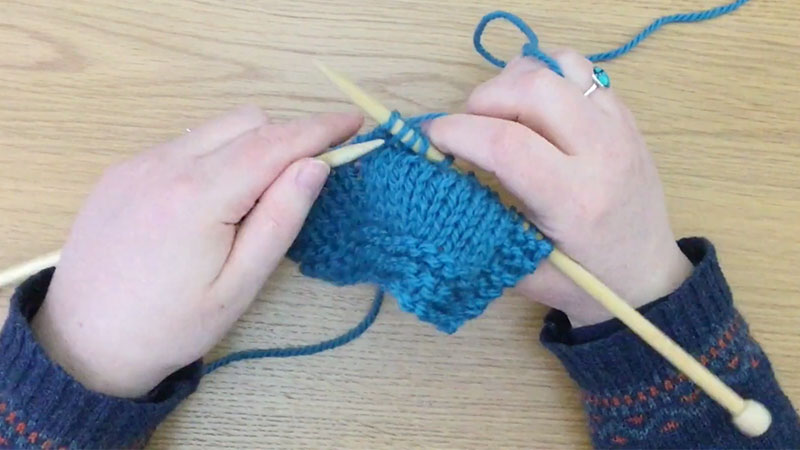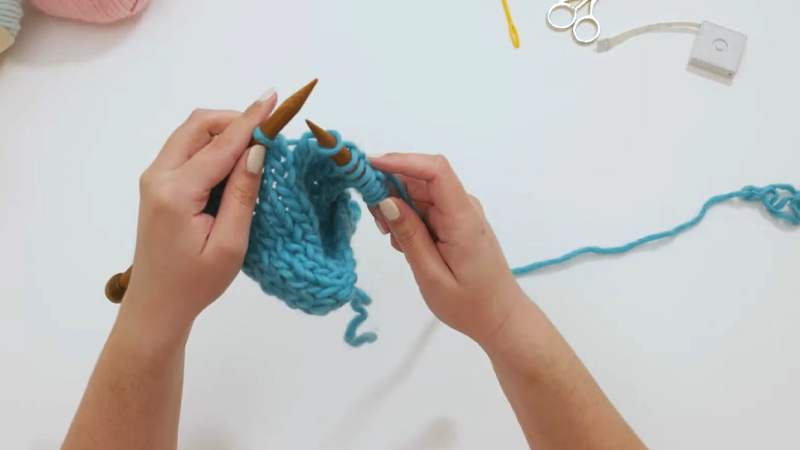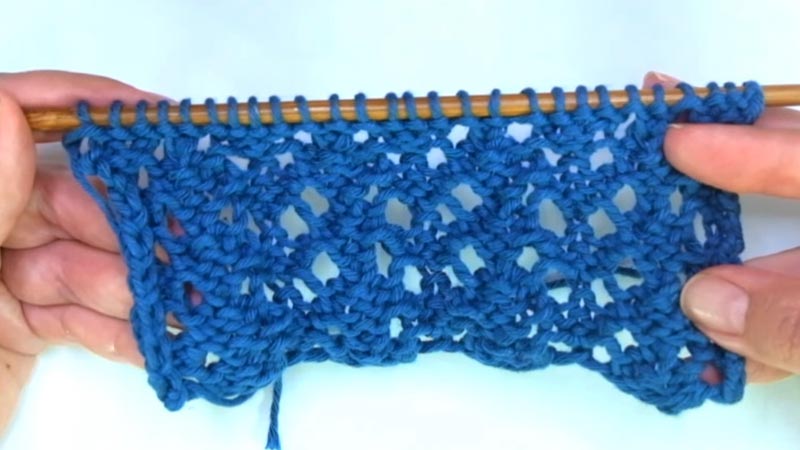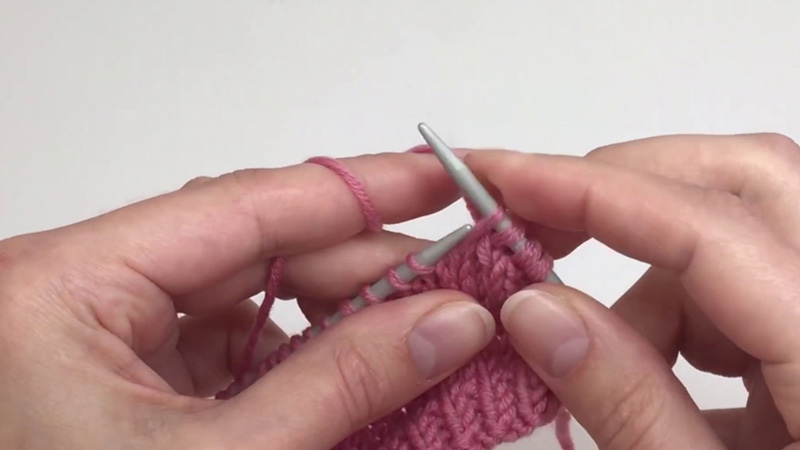In knitting, techniques and stitches abound, each contributing to the rich tapestry of textures and patterns that make up this craft.
One such technique, known as SKPO, is a fundamental skill that every knitting enthusiast should have in their repertoire.
SKPO stands for Slip, Knit, Pass Over, and it’s a crucial decrease method used to shape your knitting projects while maintaining a uniform and elegant look.
This technique creates a left-leaning decrease, which can be employed in various projects, from lacework to garment shaping.
In just three simple steps, SKPO allows you to decrease stitches gracefully, adding both form and function to your knitting endeavors.

What Is SKPO in Knitting?
SKPO, which stands for Slip, Knit, Pass Over, is a common knitting decrease technique used to reduce the number of stitches in a row while maintaining the integrity of the stitch pattern.
This decrease is often used in lace knitting, as well as in various other knitting projects where shaping is required.
SKPO creates a left-leaning decrease, which means that the stitch that was slipped and the stitch that was knitted together appear to slant to the left.
Here’s what does SKPO mean in knitting:
Slip
Slip one stitch from the left-hand needle to the right-hand needle without knitting it. To do this, insert the right-hand needle into the first stitch on the left-hand needle as if you were going to knit it, but instead of knitting it, simply slide it onto the right-hand needle.
Knit
Knit the next stitch on the left-hand needle. This is done in the usual way by inserting the right-hand needle into the stitch, wrapping the yarn around the needle, and pulling the new stitch through.
Pass Over
Using the left-hand needle, lift the slipped stitch (the one you slipped in step 1) over the knitted stitch (the one you knitted in step 2) and off the right-hand needle.
This action effectively decreases one stitch by passing the slipped stitch over the knitted stitch.
After completing these three steps, you will have decreased one stitch, and the decrease will slant to the left.
Why to Use SKPO

SKPO, which stands for Slip, Knit, Pass Over, is a knitting decrease technique that should be in every knitter’s repertoire. It offers several advantages that make it a valuable choice in various knitting projects.
Let’s explore the compelling reasons why you should consider using SKPO:
Clean and Neat Decrease
SKPO creates a polished and tidy decrease in your knitting. The process involves slipping a stitch, knitting the next stitch, and passing the slipped stitch over, resulting in a smooth and visually pleasing decrease.
This clean finish is especially beneficial in projects where a neat appearance is essential, such as garments or accessories.
Texture Preservation
Unlike some other decrease techniques that can disrupt the stitch pattern or texture of your fabric, SKPO excels at maintaining the integrity of your knitting.
This makes it an excellent choice for patterns with intricate textures, cables, or lacework, as it minimizes the distortion of the design.
Left-Slanting Decrease
SKPO produces a decrease that slants to the left. This left-leaning decrease is valuable for creating shaping elements in your projects, such as decreasing sleeves, necklines, or the tips of mittens and socks.
It pairs beautifully with right-slanting decreases like K2tog to achieve balanced shaping.
Lace Knitting
SKPO is particularly well-suited for lace knitting. Lace patterns often rely on decreases to create delicate and intricate designs.
SKPO provides a subtle, decorative decrease that complements the openwork nature of the lace, giving your lace projects a polished and professional look.
Decreasing at the Edge
When you need to decrease stitches at the very beginning or end of a row, SKPO is an excellent choice.
It ensures that your decreases are both functional and aesthetically pleasing, maintaining the overall appearance of your work.
Efficiency and Speed
Once you become proficient at the SKPO technique, it can be executed efficiently and quickly. The slip-,knit, pass-over sequence becomes second nature with practice, allowing you to progress through your knitting projects with ease.
Versatility
SKPO is a versatile decrease that can be used in a wide range of knitting projects. Whether you’re working on garments, accessories, or decorative items, knowing how to execute SKPO opens up creative possibilities and ensures a professional finish.
Creative Applications of SKPO
While the SKPO (Slip, Knit, Pass Over) decrease is a fundamental technique in knitting, it’s far from mundane. In fact, SKPO can be a versatile and creative tool in your knitting repertoire.
Explore some imaginative and artistic applications of SKPO:
Lace Patterns

Lace knitting often relies on decreases to create intricate, openwork designs. SKPO is a favorite choice in lacework because it produces a subtle, decorative decrease that complements the delicate nature of lace. Use SKPO to shape the intricate motifs in lace shawls, scarves, and doilies.
Textured Fabrics
If your knitting project involves textured stitches like bobbles, cables, or seed stitch, SKPO can be used strategically to shape your work while maintaining the texture’s integrity.
Unlike some other decrease techniques that disrupt the pattern, SKPO blends seamlessly into the fabric.
Eyelets and Buttonholes
SKPO can be used creatively to create eyelets or buttonholes. By working a series of SKPO decreases in a row, you can form decorative holes in your knitting.
This technique is perfect for adding functional and aesthetic buttonholes in cardigans or lace eyelets in summer tops.
Shaping in Amigurumi
If you’re into knitting toys and amigurumi, SKPO can be used for shaping and creating unique features.
For instance, use SKPO decreases to shape the nose or create indents for eyes on a stuffed animal’s face.
Seamless Garments
When knitting seamless garments, such as top-down sweaters, SKPO can be used for shaping the shoulders or yoke.
Its clean and tidy decrease helps maintain a polished look, and it can be strategically placed for a flattering fit.
Decorative Edges
SKPO can be employed along the edges of your knitting to create a decorative finish. For example, you can use SKPO as a decrease technique for the border of a shawl, producing a lovely scalloped or picot edge.
Combining with Other Stitches
Get creative by combining SKPO with other stitches to create unique patterns and textures. Experiment with incorporating SKPO into cable designs or as part of a larger stitch pattern.
Designing Your Patterns
If you’re an adventurous knitter, you can design your patterns around the SKPO decrease. This allows you to create custom projects that showcase the unique qualities of SKPO, whether it’s for a distinctive lace motif or a one-of-a-kind textured piece.
Colorwork
SKPO can also be incorporated into colorwork knitting to create subtle decreases within your colorwork patterns. This adds a layer of sophistication to your colorwork projects.
Customizing Garment Fit
SKPO can be used to customize the fit of your garments further. By strategically placing SKPO decreases, you can tailor your project to your body shape, achieving a more flattering and comfortable fit.
Practical Tips for Mastering SKPO

Mastering the SKPO (Slip, Knit, Pass Over) decrease in knitting can elevate your skills and help you achieve cleaner, more polished results in your projects.
Here are some practical tips to help you become proficient in using SKPO:
Understand the Basics
Before diving into SKPO, ensure you have a solid grasp of fundamental knitting techniques like knitting, purling, and slipping stitches. SKPO builds on these skills.
Use the Right Needle Size
Choose the appropriate needle size for your project and yarn weight. The correct needle size ensures your stitches are neither too tight nor too loose when working the SKPO decrease.
Practice on a Swatch
Practice SKPO on a small swatch of your project yarn before applying it to your main project. This allows you to familiarize yourself with the technique and gauge its impact on your chosen yarn.
Maintain Tension
Keep your yarn tension consistent while working SKPO. Inconsistent tension can result in uneven stitches and affect the overall appearance of your knitting.
Slip the Stitch Correctly
When slipping a stitch in SKPO, slip it purlwise (as if to purl) to prevent twisting. Twisted slipped stitches can lead to twisted decreases.
Knit Neatly
When knitting the next stitch after slipping, ensure that you knit smoothly and evenly. Avoid splitting the yarn or creating loose stitches.
Pass Over Tightly
When passing the slipped stitch over the knitted stitch in SKPO, do so firmly but without pulling too tightly. An excessively tight pass-over can distort your work.
Practice on Both Sides
Work on both the right side and wrong side of your knitting to ensure you can execute SKPO in various contexts. This is especially important for projects like reversible scarves or blankets.
Count Your Stitches
Keep track of your stitches and decreases. SKPO involves two stitches becoming one, so you should always have a consistent stitch count if your pattern requires it.
Use Stitch Markers
If your pattern involves multiple SKPO decreases within a row, consider using stitch markers to help you keep track of where to perform the decreases.
Read Patterns Carefully
Pay close attention to your knitting pattern’s instructions. Some patterns may use different terminology or variations of the SKPO technique, so follow the pattern’s guidance precisely.
Practice Regularly
Like any knitting skill, practice makes perfect. Dedicate some time to practice SKPO regularly, especially if you’re new to the technique. You’ll become more confident and efficient over time.
Seek Help and Resources
If you’re struggling with SKPO or have questions, don’t hesitate to seek help from knitting communities, books, or online tutorials. Sometimes, seeing the technique demonstrated can be very helpful.
Stay Patient
Knitting, including SKPO, can be challenging at first. Be patient with yourself and allow room for improvement. Over time, you’ll develop muscle memory and confidence in your skills.
Experiment and Get Creative
Once you’ve mastered the basics of SKPO, don’t be afraid to experiment with the technique in your projects. Combine it with other stitches or use it in innovative ways to create unique designs.
FAQS
What does SKPO mean in knitting?
SKPO stands for “Slip, Knit, Pass Over” in knitting.
When should I use SKPO in my knitting projects?
SKPO is commonly used in knitting when you need a left-slanting decrease.
Can SKPO Be Used for Right-Slanting Decreases? A1: No, SKPO is specifically designed for left-slanting decreases. If you need a right-slanting decrease, consider using other techniques like K2tog (Knit Two Together).
Does SKPO Work for All Yarn Weights?
SKPO can be used with various yarn weights, but it’s important to match your needle size to the yarn weight for a balanced result. Adjust your needle size accordingly.
Can SKPO Be Reversed for a Right-Handed Version?
Yes, if you’re a right-handed knitter, you can reverse the SKPO instructions by slipping the stitch purlwise with the right needle, knitting the next stitch, and then passing the slipped stitch over.
Are There Any Special Considerations for SKPO in Circular Knitting?
In circular knitting, SKPO is worked in the same way as in flat knitting.
Can SKPO Be Used in Combination with Other Decrease Techniques?
Absolutely! SKPO can be combined with other decrease techniques to create unique stitch patterns and textures.
Wrap Up
Understanding SKPO (Slip, Knit, Pass Over) in knitting is like discovering a versatile tool in a craftsperson’s toolkit.
This simple yet powerful decrease technique opens doors to creativity and precision in your knitting projects.
Whether you’re crafting intricate lace patterns, maintaining texture in textured fabrics, or shaping garments with finesse, SKPO plays a crucial role.
It imparts a clean, left-slanting decrease while preserving the aesthetic and functional integrity of your work. SKPO isn’t just a stitch; it’s a skill that empowers you to elevate your knitting to new heights.
So, embrace SKPO with confidence and embark on a knitting journey filled with beautiful, expertly crafted creations.
Leave a Reply